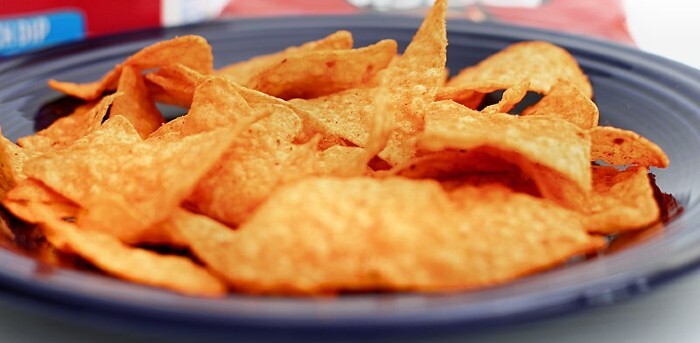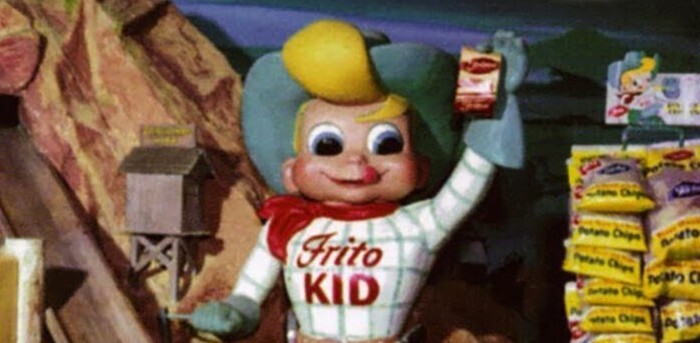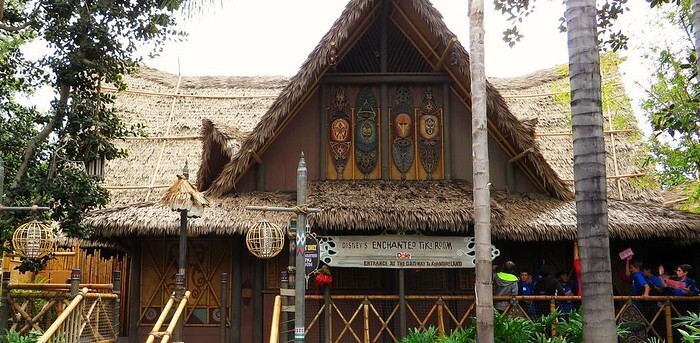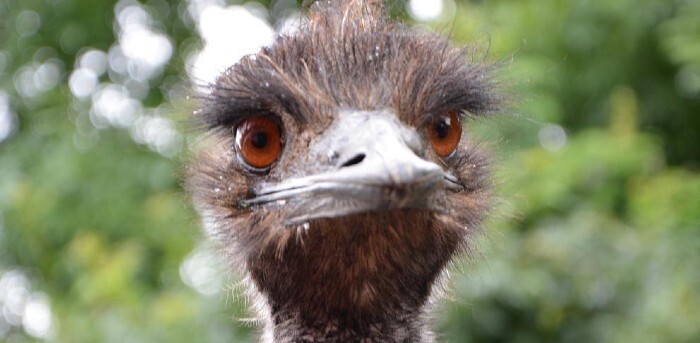Disney Food: From Doritos to the Gray Stuff Controversy

An integral part of the Disney experience, alongside trying to spot the real skeletons on Pirates of the Caribbean and subtly ogling the Princesses from a respectful distance, is eating truly cartoonish food. After all, there are few other places in the world where walking around with a giant turkey leg is socially acceptable. Disney knows that and takes it seriously -- sometimes a little too seriously.
Doritos

It feels like Doritos were handed down by the gods themselves when the world was created, but they were actually invented at Disneyland. In the early ‘60s, the Casa de Fritos restaurant in Frontierland started frying up their leftover tortillas, and hungry guests in between racial stereotypes loved the garbage chips.
The Frito Kid

You could also, of course, get Fritos at Casa de Fritos, but you’d have to negotiate with the terrifying, crazy-eyed Frito Kid. He was really little more than a glorified vending machine, but “upon inserting your nickel, the Frito Kid figure would come to life, turning his head, licking his upper lip, slowly moving his eyes side to side,” before calling to an unseen character to deliver a bag of Fritos from the depths of hell, where the Frito Kid surely reigned.
The Blue Bayou Must Be Infested

When New Orleans Square opened in Disneyland in 1966, its crowning jewel, the Blue Bayou, was ready to go, but the thorn in its future side, the Pirates of the Caribbean, wasn’t. Under anyone else’s supervision, this wouldn’t have been a problem, but Walt Disney kept the restaurant closed until they could open together because “It’s a bad show to look out at the bayou without pirate boats floating by.” After all, it’s impossible to eat crab without the threat of marauding.
The Enchanted Tiki Room’s Restaurant Was Killed For Being Too Good

The Enchanted Tiki Room was supposed to be a restaurant, but the design team ran into problems pretty quickly. When Walt was still envisioning live birds, he worried they would poop on the food, but those worries were soon eclipsed by the probability that the attraction would be too popular and a restaurant couldn’t hold as many guests as a theater and that diners would be too enchanted by the birds to ensure a quick turnover. That sucked for Stouffer, who was supposed to be the restaurant’s sponsor, so Disney just built them a different restaurant. He could do that.
Dole Whip Exists Because of Corporate Sponsorship

The Tiki Room got its sponsor, which is the whole reason Dole Whip exists. When Dole took over the attraction in 1976, they initially just served pineapple juice and spears but soon figured out they’d need something a little more exciting to get the crowd hyped for pineapples. Before Dole, it was sponsored by United Airlines, so had it not changed hands, we might be enjoying stale bagels instead.
Aunt Jemima’s Pancake House of Horrors
Disney’s corporate food sponsors could be pretty problematic. Aunt Jemima’s Pancake House might not have been any worse than the existence of the mascot, but a woman dressed as the stereotypical character also performed in the restaurant, singing and posing for photos. Aunt Jemima’s Pancake House closed in 1970, but only because Quaker Oats, its parent company, pulled out of Disneyland.
Disney’s Weird Relationship With McDonald’s

In a coincidence you’d call bullshit on if you saw it in a biopic, the two men with arguably the biggest influence on Western culture, Walt Disney and McDonald’s founder/thief Ray Kroc, met as ambulance drivers in World War I long before they struck gold. Kroc tried to leverage this connection to get a McDonald’s in Disneyland, but Disney turned him down, only wanting, you know, real brands in his park. His ghost ended up eating those words, but even after McDonald’s took over the world, Disney locked them into unfair advertising contracts and only relented on the in-park restaurant in 2001. It closed seven years later.
Disney’s Failed Fast Food Franchise
In 1990, Disney decided to get into the fast food game themselves by opening the first Mickey’s Kitchen in southern California and then another in Illinois in 1991. They prided themselves on offering healthier fast food, but it turns out kids don’t want that shit, and it costs a lot more than a Happy Meal, so parents don’t want it, either. By 1992, the Mickey’s Kitchen experiment was declared a failure.
Smellitizers

Ever wonder why the Main Street bakery smells so good even during nonstandard baking hours? The Disney parks have secret vents called Smellitizers hidden all over the place to reel you in with the salty sea spray of Pirates of the Caribbean, the acrid dust of an Indiana Jones dig, or, yes, the popcorn stands and baking shops.
One Restaurant Bans Children
It’s kind of like PetSmart having a “no dogs” area, but one restaurant, Disney World’s Victoria & Albert’s, doesn’t allow children under the age of 10 into its fancy space. It also requires formal attire, so here’s hoping you brought your tux, Disney adults.
Mickey-Shaped … Cucumbers?
No visit to Disney is complete without an artery-clogging treat in the image of the mouse god, but Disney World has taken this idolatry to Moreauian heights. Much of the ingredients in its foodier foods are grown right there at EPCOT, where gardners stifle pumpkins in round plastic Mickey heads so they grow “ears” and choke cucumbers in long tubes that force them to create Mickey heads when sliced.
What Exactly is the Blue and Green Milk?

(Disney)
For one thing, it ain’t milk. The Star Wars drinks are made from a “rice and coconut base” and then flavored with either tropical or citrus fruits. It’s unclear how banthas and thala-sirens produce such flavors in their milk, but we’re no space scientists.
People Kept Stealing Sporks
While you’re debating the merits of each flavored non-milk, be advised that you won’t be able to get a cool metal spork with your meal at Galaxy’s Edge unless you buy it. That’s because people kept stealing them and selling them on eBay for hundreds of dollars. This is why we can’t have weird things.
The Gray Stuff is Not the Gray Stuff

(Disney)
When Disney World started selling the Gray Stuff in 2013, Beauty and the Beast fans were excited to try it -- after all, it’s allegedly delicious -- but confused about why it came on a cupcake. It makes no sense for a sweet cream to be served on the platter Lumiere offers Belle in the movie, which is filled with savory appetizers. It’s more likely that the “real” Gray Stuff is a pate of some kind, but Disney threw all continuity out the window by offering this cookies-and-cream bullshit, which wasn’t even available in 18th-century France. Get your pitchforks!
Emu Legs

In 2017, Zachary Levi A.K.A. Flynn Ryder repeated an old rumor about Disney’s coveted turkey legs actually coming from emus, sending everyone into a panic. Reporters gathered entire teams of experts to settle the matter (because it’s not like Disney would tell the truth), who concluded that the legs are indeed turkey, just special ones genetically engineered for thick thighs. See? Nothing weird at all!
Top image: Omar Lopez/Unsplash